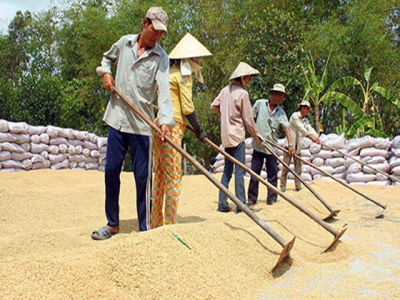Rice exports slump, food association seeks government help

The Vietnam Food Association has sought central bank assistance to buy surplus stock as rice exports plunge.
People working on a rice drying yard in Western Vietnam. Photo by VnExpress/Cuu Long.
In the first two months of the year, Vietnam exported 788,000 tons of the grain worth worth $355 million, down 4.9 percent and 17.5 percent year-on-year, respectively, according to the Ministry of Industry and Trade.
Rice exports to China, Vietnam’s biggest buyer, went down; and in a double blow for exporters, prices also fell sharply. Currently export prices are at VND4,300 - 5,000 ($0.19 - $0.22) per kilogram depending on the variety, VND800 - 1,000 lower than a year ago.
The ministry said importing countries were sourcing their rice from more suppliers, and the resultant competition has pushed prices down.
Besides, many countries have been seeking to increase rice production, increasing global supply, making it a buyers’ market.
At a recent conference on rice production held in the Mekong Delta province of Dong Thap, the association called on the State Bank of Vietnam to provide credit to help businesses buy surplus rice.
This would allow farmers to sell their produce and prepare for the upcoming summer-autumn crop, it said.
According to the Ministry of Agriculture and Rural Development, Vietnam is the third biggest rice exporter in the world behind India and Thailand, selling the grain to some 150 countries and territories.
In 2018, rice exports grew 5.1 percent in volume (6.1 million tons) and 16.3 percent ($3.08 billion) in value year-on-year.
Có thể bạn quan tâm
 Rice consumption remains stagnant
Rice consumption remains stagnant Farmers in Mekong Delta provinces grew rice on an area of 1.6 million hectares this winter-spring rice crop with total yield of about 11 million tons
 Credit institutions asked to aid disease-hit pig farmers
Credit institutions asked to aid disease-hit pig farmers On Thursday directed credit institutions to support their borrowers who raise pigs and are suffering losses due to African swine fever (ASF).
 Forming value chains to enhance competitiveness for pig farmers
Forming value chains to enhance competitiveness for pig farmers The pig industry plays an important role in the Asia Pacific, but, like other sectors, is facing challenges such as price volatility, food safety concerns